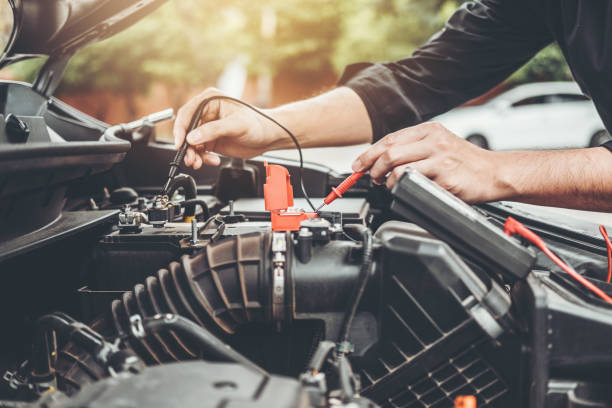When it comes to charging your car battery, time and proper steps are crucial. Simply hopping into the car and driving for a few minutes may not cut it. Initially, you should gauge the battery’s current state by using a voltmeter to measure its voltage. After getting a reading, ensure that the alternator and the overall charging system are in top shape. Further steps include scrutinizing the wiring for corrosion or damage and driving your car for a solid 30 minutes at highway speeds to achieve a full battery recharge. Don’t forget to re-check the voltage, and if necessary, assess the specific gravity of the battery’s electrolyte.
Table Of Contents
−- Measuring Your Battery’s Voltage
- Evaluating the Alternator
- Assessing the Charging System
- Inspecting Wiring and Connections
- Removing Corrosion From Battery Terminals
- The Importance of a 30-Minute Drive
- Re-checking Voltage Post-Drive
- Checking the Battery’s Specific Gravity
- Ongoing Monitoring of the Electrical System
- The Value of Regular Maintenance
Measuring Your Battery’s Voltage
Before even thinking about charging the battery, you must know its voltage. Using a multimeter, ensure that the voltage is no less than 12.4 volts. Anything less signals that your battery needs charging. Conversely, if the reading is above this value, it might indicate that your battery is in good health—or it could signal an issue with the alternator or another part of the charging system.

Evaluating the Alternator
The alternator is your battery’s best friend—it keeps it charged as you drive. A faulty alternator can drain the battery quickly, making it imperative to inspect it thoroughly. Ensure that all its components, such as belts, wires, and connections, are in excellent condition. Replace worn or damaged parts before proceeding to charge the battery.
Assessing the Charging System
Your car’s charging system does more than just help the alternator; it plays a key role in keeping your battery in tip-top shape. This system consists of several components, including the voltage regulator and wiring system. Have a professional mechanic test these components if you’re uncertain about their condition. Once you get the all-clear, you can focus on other aspects of battery care.
Inspecting Wiring and Connections
Your battery won’t charge efficiently if there are loose or corroded connections. Make it a point to check that all wires are secure and inspect the terminals for corrosion. Use a suitable cleaner to remove any buildup and consider replacing damaged wiring to ensure the flow of electricity is unhampered.
Removing Corrosion From Battery Terminals
Overlooking corroded battery terminals can impede your battery from fully charging. Corrosion acts as an insulator that prevents the flow of electricity. A wire brush can be quite effective in removing corrosion, allowing you to regain a reliable connection to your battery.
The Importance of a 30-Minute Drive
On average, driving your car for about 30 minutes at highway speeds should suffice to fully recharge a depleted battery. But remember, that’s an average. A badly worn-out battery may take much longer to charge. While 30 minutes should restore enough power for basic functionality, driving a bit longer is advisable for a complete recharge.
Re-checking Voltage Post-Drive
Once you’ve taken that crucial 30-minute drive, it’s time to recheck the battery voltage. If the reading is still not up to par, you may need to investigate further. This could involve another inspection of the alternator or charging system to ensure everything is in working order.
Checking the Battery’s Specific Gravity
An often-overlooked aspect of battery charging is its specific gravity, a measure of the battery’s charge level. You can use a hydrometer to do this. A fully charged battery should read between 1.265 to 1.299. Anything lower suggests the battery isn’t fully charged and needs more time on the road.
Ongoing Monitoring of the Electrical System
Maintaining a healthy battery doesn’t end with a one-time charge. It’s critical to regularly monitor your car’s electrical system. The voltage of a fully charged battery should ideally fall between 12.4 and 12.7 volts. Plus, always heed any warning lights on your dashboard—they’re there for a reason and could signal an issue requiring professional attention.
The Value of Regular Maintenance
While it may seem tedious, consistent preventive maintenance can save you from the sudden inconvenience of a dead battery. Regularly check the charging system and electrical components. Drive your car for at least 30 minutes each week to recharge the battery and follow it up with a voltage check. By doing so, you’re less likely to encounter any unwelcome surprises when you turn the ignition key.
Understanding the ins and outs of your car’s battery and charging system can seem daunting. However, the reward for your diligence is a vehicle that’s ready to go when you are. The keys to success are continuous monitoring and preventive maintenance. With these, you’ll have a reliable car that serves you well for years to come.

Editorial Staff
Our writers, editors, content managers, and SEO specialist. We all take part in crafting amazing articles. We spend hours ensuring that each article is based on facts, researched, and thorough. You'll never want to click the back button to look for more answers other than here!
